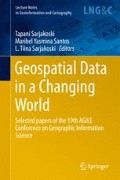Abstract
Space-time paths and prisms based on the time geographic framework model actual (empirical or simulated) and potential mobility, respectively. There are well-established methods for quantitatively measuring similarity between space-time paths, including dynamic time warping and edit-distance functions. However, there are no corresponding measures for comparing space-time prisms. Analogous to path similarity, space-time prism similarity measures can support comparison of individual accessibility, prism clustering methods and retrieving prisms similar to a reference prism from a mobility database. In this paper, we introduce a method to calculate space-time prism similarity through temporal sweeping. The sweeping method generates temporal profile curves summarizing dynamic prism geometry or semantic content over the time span of the prism’s existence. Given these profile curves, we can apply existing path similarity methods to compare space-time prisms based on a specified geometric or semantic prism. This method can also be scaled to multiple prisms, and can be applied to prisms and paths simultaneously. We discuss the general approach and demonstrate the method for classic planar space-time prisms.
Access this chapter
Tax calculation will be finalised at checkout
Purchases are for personal use only
References
Andrienko N, Andienko G, Pelekis N, Spaccapietra S (2008) Basic concepts of movement data. In: Giannotti F, Pedreschi D (eds) Mobility, data mining and privacy. Springer, Heidelberg, pp 15–38
Batty M (2010) Space, scale, and scaling in entropy maximizing. Geogr Anal 42:395–421
Briggs D (2005) The role of GIS: coping with space (and time) in air pollution exposure assessment. J Toxicol Environ Health Part A 68:1243–1261
Burns LD (1979) Transportation, temporal and spatial components of accessibility. Lexington Books, Lexington
Dodge S, Laube P, Weibel R (2012) Movement similarity assessment using symbolic representation of trajectories. Int J Geogr Inf Sci 26:1563–1588
Espeter M, Raubal M (2009) Location-based decision support for user groups. J Location Based Serv 3:165–187
Giorgino T (2009) Computing and visualizing dynamic time warping alignments in R: the dtw package. J Stat Softw 31:1–24
Gudmundsson J, Laube P, Wolle T (2012) Computational movement analysis. In: Kresse W, Danko DM (eds) Springer handbook of geographic information. Springer, Berlin, pp 423–438
Hägerstrand T (1970) What about people in regional science? Pap Reg Sci Assoc 24:1–12
Janowicz K, Raubal M, Kuhn W (2011) The semantics of similarity in geographic information retrieval. J Spat Inf Sci 2:29–57
Kobayashi T, Miller HJ (2014) Exploratory visualization of collective mobile objects data using temporal granularity and spatial similarity. In: Cervone G, Lin J, Waters N (eds) Data mining for geoinformatics: methods and applications. Springer, pp 127–154
Kuijpers B, Othman W (2009) Modeling uncertainty of moving objects on road networks via space-time prisms. Int J Geogr Inf Sci 23:1095–1117
Long JA, Nelson TA (2012) Time geography and wildlife home range delineation. J Wildl Manage 76:407–413
Long JA, Nelson TA (2013) A review of quantitative methods for movement data. Int J Geogr Inf Sci 27:292–318
Miller HJ (1991) Modeling accessibility using space-time prism concepts within geographical information systems. Int J Geogr Inf Syst 5:287–301
Miller HJ (2005) A measurement theory for time geography. Geogr Anal 37:17–45
Miller HJ, Bridwell SA (2009) A field-based theory for time geography. Ann Assoc Am Geogr 99:49–75
Nanni M, Kuijpers B, Körner C, May M, Pedreschi D (2008) Spatio-temporal data mining. In: Giannotti F, Pedreschi D (eds) Mobility, data mining and privacy. Springer, pp 267–296
Okabe A, Sugihara K (2012) Spatial analysis along networks: statistical and computational methods. Wiley
O’Sullivan D, Unwin D (2010) Geographic information analysis, 2nd edn. Wiley, Hoboken
Pfoser D, Jensen CS (1999) Capturing the uncertainty of moving-object representations. In: Güting RH, Papadias D, Lochovsky F (eds) Advances in spatial databases: 6th international symposium (SSD’99), vol 1651. Springer Lecture Notes in Computer Science, Berlin, pp 111–131
Pred A (1977) The choreography of existence: comments on Hagerstrand’s time-geography and its usefulness. Econ Geogr 53:207–221
Raubal M, Miller HJ, Bridwell S (2004) User-centered time geography for location-based services. Geografiska Annaler B 86(4):245–265
Sakoe H, Chiba S (1978) Dynamic programming algorithm optimization for spoken word recognition. IEEE Trans Acoust Speech Signal Process 26:43–49
Sinha G, Mark DM (2005) Measuring similarity between geospatial lifelines in studies of environmental health. J Geogr Syst 7:115–136
Song Y, Miller HJ (2014) Simulating visit probability distributions within planar space-time prisms. Int J Geogr Inf Sci 28:104–125
Winter S, Yin ZC (2010a) The elements of probabilistic time geography. Geoinformatica 15:417–434
Winter S, Yin ZC (2010b) Directed movements in probabilistic time geography. Int J Geogr Inf Sci 24:1349–1365
Yuan Y, Raubal M (2012) Extracting dynamic urban mobility patterns from mobile phone data. In: Xiao N, Kwan M-P, Goodchild M, Shekhar S (eds) Geographic information science—seventh international conference, GIScience 2012, Columbus, Ohio, USA, Sept 18–21 2012, Proceedings. Springer, Berlin, pp 354-367
Yuan Y, Raubal M (2014) Measuring similarity of mobile phone user trajectories: a spatio-temporal edit distance method. Int J Geogr Inf Sci 28:496–520
Author information
Authors and Affiliations
Corresponding author
Editor information
Editors and Affiliations
Rights and permissions
Copyright information
© 2016 Springer International Publishing Switzerland
About this paper
Cite this paper
Miller, H.J., Raubal, M., Jaegal, Y. (2016). Measuring Space-Time Prism Similarity Through Temporal Profile Curves. In: Sarjakoski, T., Santos, M., Sarjakoski, L. (eds) Geospatial Data in a Changing World. Lecture Notes in Geoinformation and Cartography. Springer, Cham. https://doi.org/10.1007/978-3-319-33783-8_4
Download citation
DOI: https://doi.org/10.1007/978-3-319-33783-8_4
Published:
Publisher Name: Springer, Cham
Print ISBN: 978-3-319-33782-1
Online ISBN: 978-3-319-33783-8
eBook Packages: Earth and Environmental ScienceEarth and Environmental Science (R0)

